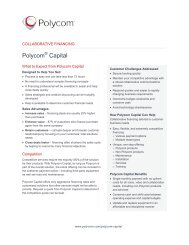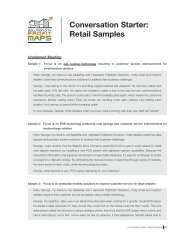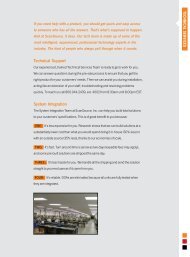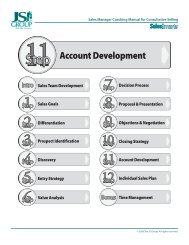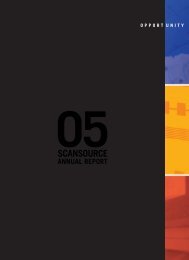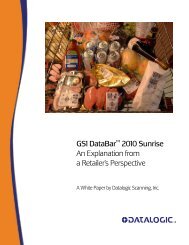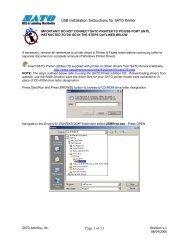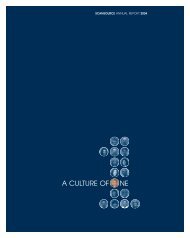Download PDF - ScanSource
Download PDF - ScanSource
Download PDF - ScanSource
You also want an ePaper? Increase the reach of your titles
YUMPU automatically turns print PDFs into web optimized ePapers that Google loves.
SCANSOURCE, INC. AND SUBSIDIARIES<br />
Notes to Consolidated Financial Statements<br />
June 30, 2007<br />
Foreign Currency<br />
The currency effects of translating the financial statements of the Company’s foreign entities that operate in their local currency are included in the cumulative<br />
currency translation adjustment component of accumulated other comprehensive income. The assets, including goodwill, and liabilities of these foreign entities are<br />
translated into U.S. Dollars using the exchange rate at the end of the respective period. Sales, costs and expenses are translated at average exchange rates effective<br />
during the respective period. Translation adjustments resulting from the translation of these entities are included in accumulated other comprehensive income in the<br />
Consolidated Balance Sheets. Foreign currency transactional and re-measurement gains and losses are included in other expense (income) in the Consolidated Income<br />
Statements. Such amounts are not significant to any of the periods presented.<br />
Income Taxes<br />
Income taxes are accounted for under the liability method. Deferred income taxes reflect tax consequences on future years of differences between the tax bases of<br />
assets and liabilities and their financial reporting amounts. Valuation allowances are provided against deferred tax assets in accordance with SFAS No. 109, Accounting for<br />
Income Taxes. Federal income taxes are not provided on the undistributed earnings of foreign subsidiaries because it has been the practice of the Company to reinvest<br />
those earnings in the business outside the United States.<br />
Deferred Income Taxes<br />
Deferred income taxes are determined in accordance with SFAS No.109, Accounting for Income Taxes. Deferred tax assets and liabilities are recognized for the<br />
expected future tax consequences attributable to differences between the consolidated financial statement carrying amounts of existing assets and liabilities and their<br />
respective tax bases, and operating loss and tax credit carryforwards. The Company evaluates the tax assets and liabilities on a periodic basis and adjusts the balances as<br />
appropriate.<br />
The Company records valuation allowances to reduce its deferred tax assets to the amount expected to be realized. In assessing the adequacy of recorded valuation<br />
allowances, the Company considers a variety of factors including, the scheduled reversal of deferred tax liabilities, future taxable income, and prudent and feasible tax<br />
planning strategies. In the event the Company determines it would be able to use a deferred tax asset in the future in excess of its net carrying value, an adjustment to the<br />
deferred tax asset would reduce income tax expense, thereby increasing net income in the period such determination was made. Likewise, should the Company<br />
determine that it was unable to use all or part of its net deferred tax asset in the future, an adjustment to the deferred tax asset would be charged to income tax expense,<br />
thereby reducing net income in the period such determination was made.<br />
Share-Based Payment<br />
Effective July 1, 2005, the Company adopted the fair value recognition provisions of SFAS 123 (R), Share-Based Payments. SFAS 123 (R) requires all shared-based<br />
payment awards to employees and non-employees to be recognized in the Company’s Consolidated Income Statement based on their fair values. Under the fair value<br />
recognition provisions of SFAS 123 (R), share based compensation is estimated at the grant date based on the fair value of the awards expected to vest and recognized as<br />
expense ratably over the requisite service period of the award. The Company has used the Black-Scholes valuation model to estimate fair value of share-based awards,<br />
which requires various assumptions including estimating stock price volatility, forfeiture rates, and estimated life.<br />
42






